
Autograph letter signed to an unidentified correspondent
Publisher Information: Warburton: 1869.
Beaufort, Daniel Augustus (1814-98). Autograph letter signed [“D. A. B.”; remainder of surname supplied in pencil in a different hand] to an unidentified correspondent. 4pp. Warburton, 15 December 1869. 139 x 191 mm. Faint trace of mounting on fore-edge of second leaf, but fine otherwise.
From Daniel Augustus Beaufort the younger, son of Rear Admiral Sir Francis Beaufort (1774-1857) and grandson of geographer Daniel Augustus Beaufort (1739-1821). Beaufort came from a scientific family: His grandfather helped to found the Royal Irish Academy and published an important map of Ireland in 1792; his father developed the Beaufort Scale for indicating wind force and served as the British Admiralty’s Hydrographer of the Navy from 1829 to 1854; and two of his aunts, Harriet and Louisa Beaufort, wrote popular works on botany and entomology. Daniel Augustus the younger was a clergyman who served as rector of Warburton from 1850 to 1872; he also had a strong interest in natural history. Beaufort’s letter reads in part as follows: "To answer your reply briefly, the animals we spoke of—by which phrase I suppose you mean those of the genus Pediculus anglici, louse—most decidedly have legs; & these like those of all true “Insects” are six in number (I say “true,” because spiders are only by a vulgar man called Insects: they, you know, have eight). "The point in which the members of the genus Pediculus differ from most other genera is that they are apterous, i.e. wingless. "I may mention as an interesting fact, that every animal is infested with accompanied by creatures of this family, having some peculiarity appropriate to each species, and they are all formed upon the type of the human specimen. Generally each animal enjoys its armies of but a single species; but there are some kinds of eagles & gulls which have the distinguished privilege of bearing no fewer than five species of these attachés. . . "In reference to your notion of Pediculus being like mites without legs, & moving themselves by springs, let me implore you to discard such a view as utterly untenable: indeed as more than indefensible. For mites—whether such as you see in cheese, or such as your son would call “Gentles,” or any other—are neither more nor less than babies: such are the infant Wasp, infant bee, infant house-fly, &c., &c. &c. If you will carefully feed, tend & watch some, you will find that the mite passes into two other forms of existence, the 3rd & mature one having wings." Book Id: 42817Price: $450.00
See all items by Daniel Augustus Beaufort
